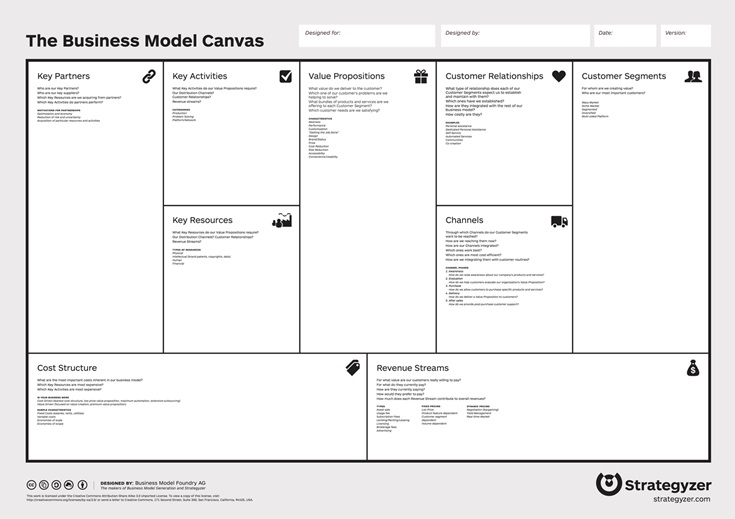The Business Model Canvas (BMC) is a strategic framework for defining how a business creates, delivers, and captures value in a single visual chart. Developed by Alexander Osterwalder and Yves Pigneur, the BMC meaning centers on simplifying complex business planning into nine structured elements—from customer segments and value propositions to revenue streams and cost structures.
By mapping these components on one page, the Business Model Canvas helps startups, entrepreneurs, and enterprises clearly understand their operating model, identify growth opportunities, and align strategy with execution.
What is a Business Model Canvas?


A Business Model Canvas is essentially a one-page document that outlines the key elements of a business model. It serves as a blueprint for how a company creates, delivers, and captures value. The canvas is divided into nine building blocks that capture the essence of a business’s operations:
- Customer Segments – Defines the different groups of people or organizations a business aims to reach and serve.
- Value Propositions – Describes the bundle of products and services that create value for a specific Customer Segment.
- Channels – Outlines how a company communicates with and reaches its Customer Segments to deliver a Value Proposition.
- Customer Relationships – Details the types of relationships a company establishes with specific Customer Segments.
- Revenue Streams – Represents the cash a company generates from each Customer Segment.
- Key Resources – Lists the most important assets required to make a business model work.
- Key Activities – Describes the most important things a company must do to make its business model work.
- Key Partnerships – Identifies the network of suppliers and partners that make the business model effective.
- Cost Structure – Represents all the costs involved in operating a business model.
Also read: 12 Types of Business Sectors: Delving into Various Business Worlds
Benefits of Using a Business Model Canvas
- Clarity and Focus: The canvas helps in clearly defining and focusing on the essential components of your business model.
- Simplicity and Accessibility: It provides a simple and accessible format for brainstorming, planning, and communicating a business strategy.
- Flexibility: The Business Model Canvas is easy to update and modify, making it a living document that evolves with your business.
- Enhanced Collaboration: Facilitates collaboration and alignment across different departments and stakeholders by providing a shared understanding.
Also read: Business Opportunity: The Secret to Success in the Business
Key Building Blocks Explained


- Customer Segments: Identify and segment the different groups of customers you aim to serve. These could be mass markets, niche markets, segmented markets, diversified markets, or multi-sided platforms.
- Value Propositions: Clearly define what makes your product or service valuable to each customer segment. This could be through innovative features, improved performance, or unique customer experiences.
- Channels: Determine how you will deliver your value propositions to your customers. Channels can be direct or indirect, and owned or partnered.
- Customer Relationships: Decide on the type of relationship you will establish with each customer segment, ranging from personal assistance to automated services or community engagement.
- Revenue Streams: Identify how your business will earn money from each customer segment. This could be through asset sales, subscription fees, licensing, brokerage fees, or advertising.
- Key Resources: List the essential resources required to execute your business model, which can include physical, intellectual, human, and financial resources.
- Key Activities: Outline the crucial actions your business must take to succeed. These activities could be related to production, problem-solving, or maintaining a platform/network.
- Key Partnerships: Recognize external companies or suppliers that will help your business succeed. Partnerships can be strategic alliances, joint ventures, or buyer-supplier relationships.
- Cost Structure: Define the costs associated with each part of your business model. Understanding whether your business is cost-driven or value-driven will help prioritize your spending.
Also read: Business Proposal: Definition, Benefits, and How to Create One
How to Create a Business Model Canvas
Creating a Business Model Canvas involves a collaborative effort and can be done using physical tools like whiteboards and sticky notes or digital platforms like Creately. Here’s a step-by-step guide on how to create your own:
Gather Your Team and Materials
Bring together a diverse group from various departments in your company. This diversity ensures that all perspectives are covered. If using a digital platform, create a collaborative workspace and grant editing permissions to all participants.
Set the Context
Define the purpose and scope of your Business Model Canvas. Clearly articulate the business idea or project you want to analyze, ensuring everyone understands its context and goals.
Draw the Canvas
Divide your workspace into nine sections representing the nine building blocks of the Business Model Canvas. Label each section accordingly.
Identify the Key Building Blocks
Start by labeling each section: Customer Segments, Value Propositions, Channels, Customer Relationships, Revenue Streams, Key Resources, Key Activities, Key Partnerships, and Cost Structure.
Fill in the Canvas
Collaboratively fill in each section with relevant information. Use data, keywords, diagrams, and other visual aids to represent ideas and concepts clearly.
Analyze and Iterate
Once your team has filled in the canvas, analyze the relationships between the blocks to identify strengths, weaknesses, opportunities, and challenges. Discuss potential improvements and make necessary adjustments.
Finalize
Finalize the canvas as a visual reference to communicate your business model to stakeholders. Use it as a guide for making informed strategic decisions and aligning your team.
Also read: Business Risk: Definition, Types, and Ways to Overcome
Conclusion
The Business Model Canvas is an invaluable tool for any entrepreneur or business manager looking to articulate their business idea succinctly. By focusing on the core aspects of a business in a single-page format, it allows teams to identify potential gaps and refine their strategies effectively. Whether you are developing a new product or reassessing an existing business, the Business Model Canvas can provide a clear pathway to success.










